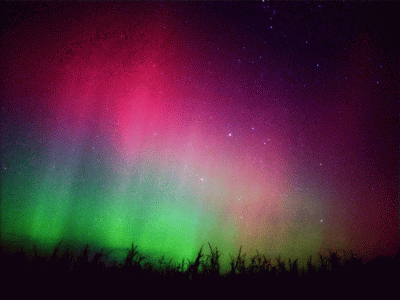Coronal mass ejections (CMEs) from the Sun send out charged particles which interact with the Earth's magnetic field and atmosphere. When these charged particles come into the Earth's outer atmosphere - the ionosphere - they interact with molecules there to create light. Since the easiest ways for the particles to enter the Earth's atmosphere is near the magnetic north and south poles, those are the areas that most often experience auroras (auora borealis near the North Pole and aurora australis near the South Pole).
The Earth's atmosphere is 78% nitrogen gas (N2) and 21% oxygen gas (O2) with 1% everything else. It's in the ionosphere, also called the thermosphere, where the charged particles (ions) from the Sun first start coming into contact with these atmospheric gases.
The color depends on whether or not the molecule being excited in oxygen or nitrogen and it depends on the orbitals an electron is jumping between (from orbital 2 back to 1, from 3 to 2, from 3 to 1, etc.). Each of these jumps gives off a photon with a characteristic wavelength of visible light energy. Oxygen emissions tend to be green or brownish-red while nitrogen emissions tend to be blue or red (if both are occuring, a purple color can be seen). Below is a nice aurora picture showing green, red, and purple light.
Green, however, is the most common color seen in an aurora. Here's an amazing time-lapse view from National Geographic of mostly-green northern lights over Norway. Their curtain-like, shimmering shape is due to the charged particles moving along the lines of force of the Earth's magnetic field.
Below is an image of the aurora borealis from the International Space Station (ISS) on September 29 as it orbited over the midwestern U.S. at night. Note the prominant lights of Chicago and St. Louis near the center of the image (from NASA's Earth Observatory web site).
Under favorable conditions, auroras can be seen here in the Hudson Valley (I saw a red one during the last sunspot cycle). So, hw can you know if a CME erupts during this sunspot cycle and there's a chance to view auroras here in the Hudson Valley (or wherever you live)? I use SpaceWeather.com which has handy email elerts you can sign up for (in addition to having lots of other neat information).








Haarp makes the ionsphere cook, and use the aurora to control peoples mind and ability.
ReplyDelete